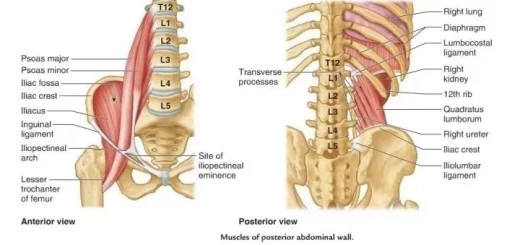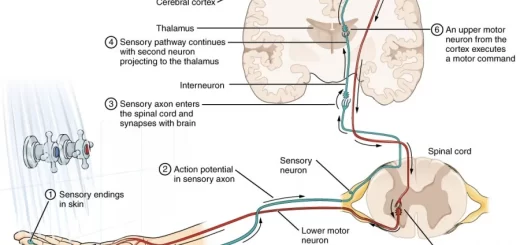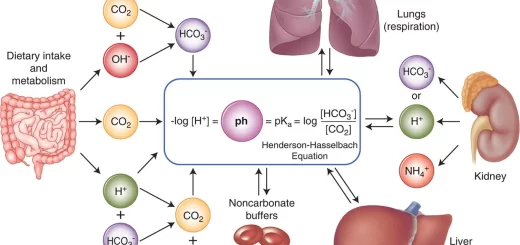Function and Physiology of Thalamus, Hypothalamus and Limbic system
The thalamus is a collection of nuclei that processes all sensory input (except the olfactory) on its way to the cortex. It also has a strong influence on the motor input from the basal ganglia and cerebellum on its way to the cortex. It has a 2-way connection with the cortex where it relays as well as processes information reaching the cortex; in return, it receives back projections from the cortex.
Physiology of the thalamus
From a physiological point of view, thalamic nuclei can be divided into nonspecific or specific nuclei. Nonspecific thalamic nuclei receive input from several sources they are generalized, functionally non-specific nuclei. They process input coming from the reticular activating system in the brainstem and project to wide areas of the cortex. They also receive input from the ascending pain pathways.
The specific thalamic nuclei receive input from specific sensory or motor systems with distinct sensory or motor functions. There are more precise projections between these nuclei and restricted cortical zones.
Functions of the thalamus
1. Sensory functions: the thalamus conveys almost all sensations to the cerebral cortex. These sensations include:
- Somatic sensations: the ventral posterior nucleus receives the large ascending somatic sensory pathways. The ventral posterior lateral (VPL) nucleus receives information from the opposite side of the body and the ventral posterior medial (VPM) nucleus receives information from the face, scalp, oral and nasal cavities, and dura.
- Special sensations: lateral and medial geniculate bodies are relay centers for visual and auditory signals respectively. The ventral posterior medial (VPM) nucleus relays taste information from the brainstem to the somatosensory cortex.
2. Motor functions: it is a relay center for motor signals through 2 nuclei; the ventral lateral nucleus which relays signals from the cerebellum and basal ganglia to the cortical motor areas and the ventral anterior nucleus which receives all its input from the basal ganglia.
3. Arousal functions: the non-specific thalamic nuclei such as the intralaminar and midline nuclei are part of the ascending reticular activating system which controls wakefulness and arousal.
4. Emotional functions: the anterior nucleus is connected with the limbic system and concerned with control of emotional reactions. The lateral dorsal nucleus (LD) receives input from the hypothalamus and projects to the cingulate cortex and contributes to the autonomic component of emotions.
5. Higher functions: the dorsomedial nucleus of the thalamus plays a role in and memory through its connection with the cerebral cortex.
Physiology the hypothalamus
The main function of the hypothalamus is to maintain homeostasis. Homeostasis is the process by the internal physiological and chemical environment of the body is kept constant. The hypothalamus functions to keep factors such as blood pressure, body temperature, fluid, and electrolyte balance, and body weight remarkably fixed and held to a precise value called the set-point.
Specific receptors & sensors throughout the body detect changes in the normal balance of body functions and chemistry that are produced by stress stimuli that can range from injury or infection to pain and emotional distress, These data are transmitted to the hypothalamic nuclei and affect their discharge rate to restore homeostasis, Changes in discharge rate result in altered hypothalamic efferent outflow and hence change in the functions of regulatory systems that counteract the stress stimulus and restore homeostasis.
Functions of the hypothalamus
1. Regulation of the autonomic nervous system:
The hypothalamus regulates the autonomic nervous system through hypothalamic fibers that pass caudally into the reticular formation of the brainstem and conduct impulses to cells of the parasympathetic and sympathetic systems located in the brainstem and spinal cord. Stimulation of the anterior. hypothalamus causes the parasympathetic response. However, stimulation of the posterior hypothalamus produces a sympathetic response.
2. Control of endocrine functions: The hypothalamus controls functions of anterior and posterior pituitary glands through vascular and neural connections. The paraventricular and supraoptic nuclei secrete vasopressin and oxytocin.
3. Temperature regulation:
The hypothalamus is a center for body temperature regulation. Anterior hypothalamic nuclei are concerned with heat loss while posterior hypothalamic nuclei are concerned with heat productions. Peripheral temperature receptors in the skin as well as central thermoreceptors within the hypothalamic preoptic area, send information to the heat regulating canters which initiates reflex responses as shivering and peripheral vasoconstriction on exposure to cold, while sweating and peripheral vasodilatation occur on exposure to heat to maintain body temperature constant.
A patient with a lesion of the posterior hypothalamus may have a body temperature that varies with the environment like cold-blooded organisms conversely a patient with a lesion of the anterior hypothalamus may have hyperthermia.
4. Hunger and body weight: the hypothalamus contains:
- Feeding center, in the lateral nucleus.
- Satiety center, in the ventromedial nucleus.
There are different hypotheses related to the regulation of food intake by the hypothalamus:
- Glucostatic hypothesis: it postulates that the satiety center functions by inhibiting feeding centers, The activity of the satiety center in the ventromedial nuclei is controlled by glucose utilization in these neurons, When their glucose utilization is low, the activity across the neurons decreases, Under these conditions, the activity of the feeding center is unchecked & the individual feels hungry.
- Lipostatic hypothesis: this hypothesis holds that adipose tissue produces a neuropeptide called leptin. Leptin production is proportionate to the amount of fat and acts on the hypothalamus to decrease food intake and increase energy output.
- Hypothalamic neuropeptide hypothesis: there are many peptides, neurotransmitters, and receptors in the hypothalamus that are involved in appetite regulation as neuropeptide Y released from the arcuate nucleus and orexin released from the lateral nucleus both increase appetite.
Lesions in the ventromedial hypothalamus may result in obesity while lesions in the lateral hypothalamus may result in anorexia.
5. Regulation of water balance:
- The supraoptic nucleus contains a thirst center whose cells are extremely sensitive to fluid volume. If the blood volume is decreased, the thirst center is stimulated and water is ingested.
- Water balance is also regulated by the osmoreceptors in the anterior hypothalamus, These receptors respond to changes in plasma osmolality and extracellular fluid (ECF) volume resulting in vasopressin secretion (hormone of the posterior pituitary gland).
6. Relation to sleep:
- Stimulation of the anterior hypothalamus produces sleep that is mediated by GABA and galanin inhibitory neurons.
- Stimulation of the posterior hypothalamus produces arousal due to the presence of histaminergic neurons in the posterior hypothalamus that promotes wakefulness.
7. Control of circadian rhythm:
The suprachiasmatic nucleus receives direct input from the retinal ganglion cells which synchronizes body functions with daily periods of light and dark. Most living organisms have fluctuations in bodily function that are about 24 hours in length. In humans, these functions include the rhythms of ACTH secretion and melatonin secretion; sleep-wake cycles the body temperature cycle.
8. Control of emotions:
The hypothalamus is part of the limbic system, it controls the fight or flight response in response to stimulation from the amygdala. The posterior hypothalamus increases sympathetic activity through connections with the sympathetic nervous system which increases heart rate, blood pressure, blood flow to the muscles, and respiration. It also causes increased awareness and aggressive behavior.
Physiology of the limbic system
The limbic system constitutes several cortical and subcortical structures that interact together to mediate emotions. The cortical structures are formed of a band of primitive cortical tissue that encircles the upper brainstem and includes the cingulate gyrus and the parahypocampal gyrus.
The subcortical structures include the thalamus, the hippocampus, the hypothalamus and the amygdala. The limbic system is also strongly linked to the oribitofrontal cortex.
Connections of the limbic system
The structures forming the limbic system are connected together. Historicallyو the limbic system was thought to consist of only 4 structures; the hippocampus, the mammillary bodies of the hypothalamus, the anterior nuclei of the thalamus, and the cingulate gyrus. The connections between these 4 structures form a closed circuit that was called the Papez circuit.
Functions of the limbic system
1. The thalamus: is a relay station for most sensations coming from the body and most emotions are related to this sensory input.
2. The anterior cingulate: is involved in mediating ethics, and processing moral emotions, and controlling impulsive actions. The anterior cingulate is also part of a network that mediates motivation. Motivation is the desire to do something and it is usually due to some sort of anticipated reward.
The network involved in motivation and reward Includes the basal ganglia, the prefrontal cortex, and the nucleus accumbens. Dopamine triggers reward sensitivity, allowing us to stay motivated towards a reward. When we know there is a reason we are performing a task, and a reward for completing it, then we stay focused.
3. The hypothalamus: regulates the physical response to emotions by controlling the endocrine and autonomic nervous systems.
4. The hippocampus: stores memories related to emotions.
5. The amygdala is involved in:
- Consolidation of emotional memories especially of fear.
- Processes distressing stimuli associated with threat (fight or flight response)
- Important other emotions such as empathy.
- Form a part of the olfactory centers and are concerned with the emotional response to olfactory stimuli.
Diencephalon function, Thalamus, Metathalamus, Hypothalamus, Epithalamus & Subthalamus
Reticular formation, Reticular activating system & Types of EEG waves & Phases of sleep
Upper and lower motor neurons lesion, Stages of complete spinal cord transection
Anatomy of basal nuclei (basal ganglia) & Disorders of basal ganglia motor circuits



